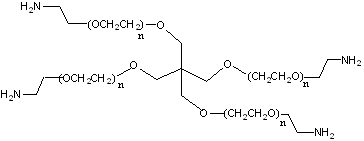Description
4-Arm PEG-Amine is a multi-armed PEG derivative with amine at each terminal of the four arms connected to one pentaerythritol core. The reactive primary amine or NH2 rapidly react with aldehyde, ketone to form imine. Imine upon further reduction forms secondary amine via reductive amination. Amine reacts with activated carboxyl acid, NHS ester (SCM, SS, SG, SC, GAS, SAS) to form stable amide bonds. 4-Arm PEG reagents are useful crosslinking reagent and to conjugate and carry multiple drug payload for drug delivery.
Properties
Molecular weight: 4-Arm PEG MW refers to the MW of the entire PEG molecule. The MW of each arm is 1/4 of the MW indicated in the product name. MW of PEG was measured by MALDI-MS or GPC. PDI (polydispersity index) of our 4-Arm PEG is 1.02-1.05 with very narrow MW distribution. The number of repeating ethylene oxide units (CH2CH2O) or the degree of polymerization is calculated dividing the PEG MW by 44 (44 is the molecular mass of one repeating unit).
Solubility: Soluble in water and aqueous buffer, chloroform, methylene chloride, DMF, DMSO, and less soluble in alcohol, toluene. Not soluble in ether.
Density: PEG density is approximately 1.125 g/mL.
Physical form: PEG products generally appear as white or off-white powder, and for very low MW 4-Arm PEG such as MW 2k, it may appear as wax-like, semi-solid material due to the low MW and the type of functional groups.
Storage condition: PEG product shall be stored in the original form as received in a freezer at -20C or lower for long term storage. Stock solution of PEG reagents that do not contain oxygen or moisture sensitive functional groups may be temporarily stored in a refrigerator or ambient temperature for multiple days. Stock solution should avoid repeated freeze-and-thaw cycles. See Documents section for detailed storage and handling conditions.
References
1. Delivery Vector for siRNA – Multi-armed cationic cyclodextrin: poly(ethylene glycol) polyrotaxanes as efficient gene silencing vectors, Integr. Biol., 2013,5, 115-121, Text.
2. Modular poly (ethylene glycol) scaffolds provide the ability to decouple the effects of stiffness and protein concentration on PC12 cells. Acta biomaterialia 7.11 (2011): 3841-3849. Text.
3. Rapid detection of polyethylene glycol sonolysis upon functionalization of carbon nanomaterials. Experimental Biology and Medicine (2015): 1535370214567615. Text
4. Low fouling label-free DNA sensor based on polyethylene glycols decorated with gold nanoparticles for the detection of breast cancer biomarkers. Biosensors and Bioelectronics 71 (2015): 51-56. Text
5. A microfluidic-based cell encapsulation platform to achieve high long-term cell viability in photopolymerized PEGNB (PEG norbornene) hydrogel microspheres, J. Mater. Chem. B, 2017, 5, 173-180, Text.
6. Chemical derivatization and biofunctionalization of hydrogel nanomembranes for potential biomedical and biosensor applications, Phys. Chem. Chem. Phys., 2016,18, 12035-12042, Text.
7. Ultraflexible, Freestanding Nanomembranes Based on Poly (ethylene glycol). Advanced Materials 26.20 (2014): 3328-3332. Text.
8. Diagnosis of LVAD Thrombus using a High-Avidity Fibrin-Specific 99mTc Probe. Theranostics. 2018;8(4):1168. Text.
9. Nanoparticle diffusion during gelation of tetra poly(ethylene glycol) provides insight into nanoscale structural evolution, Soft Matter, 2020, Text.
10. 3D Bioprinting using UNIversal Orthogonal Network (UNION) Bioinks, Adv. Funct. Mater. 2020, 2007983, Text.
11. A double-crosslinked self-healing antibacterial hydrogel with enhanced mechanical performance for wound treatment, Acta Biomaterialia 124 (2021) 139–152, Text.
12. Engineered Matrices Enable the Culture of Human Patient-Derived Intestinal Organoids, Advanced Healthcare Materials, 10, 22, (2021). Text.
13. Direct Evidence of Heteroleptic Complexation in the Macroscopic Dynamics of Metallo-supramolecular Polymer Networks, Macromolecules 2021, 54, 15
14. The Effect of Ultraviolet Light on Biorepulsive Hydrogel Poly(ethylene glycol) Films, ACS Appl. Polym. Mater. 2021, 3, 7
15. Poly(ethylene glycol) Hydrogel Crosslinking Chemistries Identified via Atmospheric Solids Analysis Probe Mass Spectrometry, Macromolecules, 2021, 54, 17
Click here to view an expanded list of hundreds of publications citing Creative PEGWorks products.


